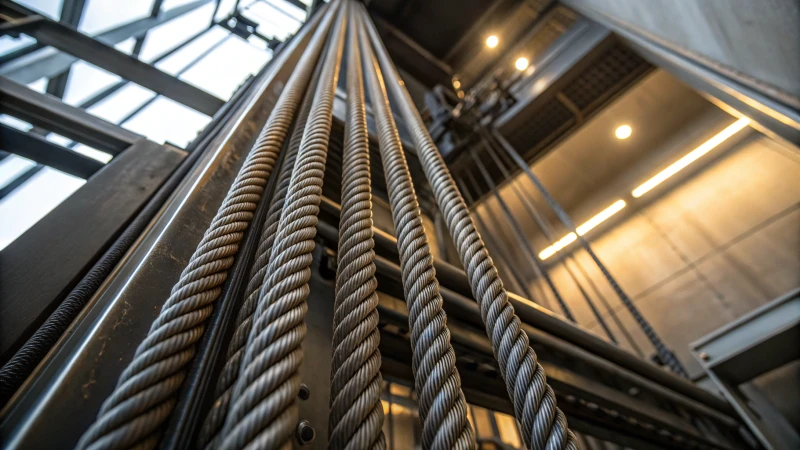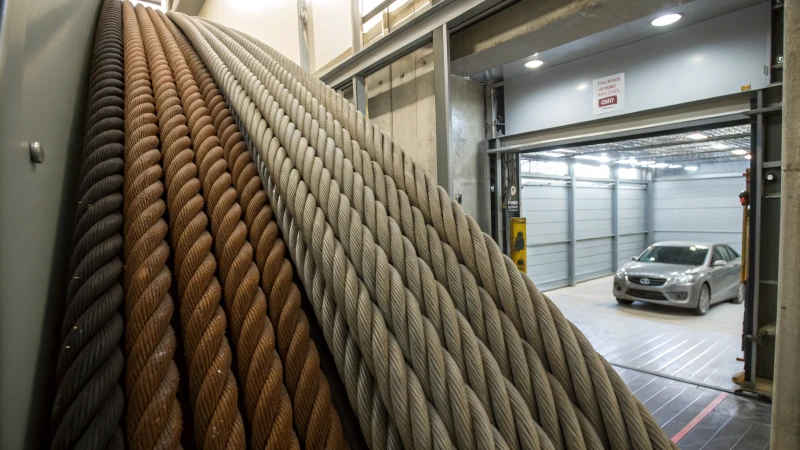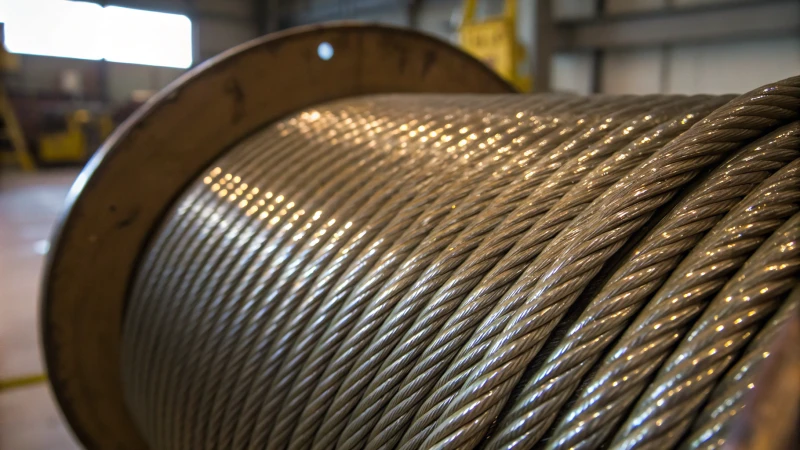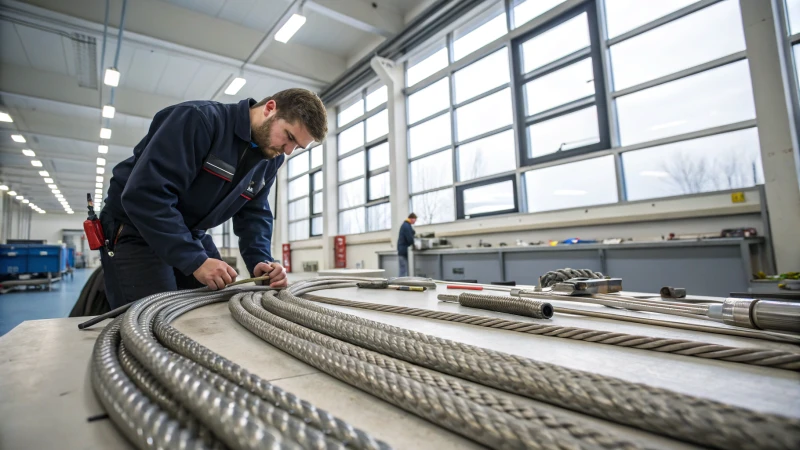
Choosing the right steel wire rope is like finding the perfect partner for your high-speed elevator.
When selecting a steel wire rope for high-speed elevators, prioritize high tensile strength and flexibility, such as 6x36 or 8x19 constructions, to ensure safe and efficient performance.
I remember the first time I was tasked with selecting steel wire ropes for a project; it felt like a daunting responsibility. I knew that the safety and efficiency of the entire elevator system rested on my decision. The nuances of choosing the right rope can indeed be overwhelming, but armed with the right insights, it becomes a manageable task. High tensile strength and flexibility are not just technical specs—they are vital lifelines in ensuring safety and performance in fast-paced environments. Delve into this guide to discover expert tips that can illuminate your path to making well-informed choices aligned with industry standards.
6x36 steel wire ropes are ideal for high-speed elevators.True
6x36 ropes offer flexibility and strength, suitable for dynamic loads.
Steel wire ropes with low tensile strength are best for elevators.False
High tensile strength is crucial for handling fast cycles and loads.
What Are the Key Factors in Choosing Steel Wire Ropes for Elevators?
Picking the right steel wire ropes for elevators feels like choosing the backbone of your building's safety and efficiency. It’s about getting that perfect blend of strength, durability, and compliance.
When choosing steel wire ropes for elevators, focus on tensile strength, flexibility, fatigue resistance, and adherence to industry standards like ISO 4344. Coatings can enhance corrosion resistance and minimize friction, ensuring longevity and performance.

Understanding the Importance of Tensile Strength
I remember the first time I had to decide on steel wire ropes for a project. It felt like choosing between stability and flexibility. Tensile strength1 is crucial because it tells us how much weight the rope can handle without snapping. For those high-rise buildings that scrape the sky, opting for higher tensile strength is non-negotiable. However, it's a balancing act because too much strength without flexibility can compromise the rope's performance.
Flexibility and Dynamic Load Handling
Flexibility reminds me of those times you have to bend backward to make things work seamlessly. In elevators, it's all about ensuring the ropes glide smoothly around pulleys, reducing wear. The 6×36 construction comes to mind—kind of like your favorite old sweatshirt, flexible and comfy. It's perfect for elevators with constant stop-and-go action. Adding a polymer coating2 is like putting on a protective layer, boosting flexibility and cutting down on friction.
| Construction Type | Characteristics | Use Case |
|---|---|---|
| 6×36 | High flexibility, fatigue resistant | High-speed elevators |
| 8×19 | Balanced strength and flexibility | Mid-range applications |
Fatigue Resistance for Longevity
Imagine running a marathon every day—elevator ropes face similar fatigue from constant bending. They need to last and keep us safe. Stainless steel ropes or those with more wires per strand stand out for their resilience. Regular checks are our best friends here; they help us spot fatigue resistance3 before it becomes an issue.
Compliance with Industry Standards
When I think of compliance, I picture a safety net that catches us before we fall. Standards like ISO 4344 ensure that the ropes don't just meet but exceed safety expectations globally. It's about peace of mind—knowing the ropes won’t let you down by adhering to these reliability standards4.
Additional Considerations: Coatings and Corrosion Resistance
Think of coatings like sunscreen for your ropes—they shield against harsh elements. If you're in a moist or chemical-prone environment, coatings like PVC or zinc become essential. Comparing different coatings is a bit like finding the right skincare routine; it’s about what suits your needs best. Comparing different coatings5 helps you make that choice with confidence.
Higher tensile strength ropes are used in high-rise buildings.True
High-rise buildings require ropes with high tensile strength for safety.
6×36 construction type is less flexible than 8×19.False
6×36 is known for higher flexibility, making it ideal for elevators.
How Do Different Wire Rope Constructions Impact Elevator Performance?
Ever thought about how the wire ropes in elevators silently shoulder so much responsibility?
Choosing the right wire rope construction is essential for elevator performance. Constructions like 6×36 and 8×19 influence factors such as flexibility, strength, and wear resistance, impacting the efficiency and safety of elevator systems.

Flexibility and Strength
I remember standing in a skyscraper's elevator, wondering about the unseen mechanisms making this smooth ride possible. That's when I learned about wire ropes, especially those like 6×366 and 8×197. Imagine the 6×36 as a finely tuned balance of flexibility and strength—it's like a well-practiced gymnast, agile yet strong, perfect for high-speed applications where a little give makes all the difference. On the other hand, the 8×19 construction reminds me of a steadfast rock climber, with thicker strands that promise durability and robustness, crucial for environments demanding hefty load-bearing capacity.
| Construction Type | Flexibility | Tensile Strength | Wear Resistance |
|---|---|---|---|
| 6×36 | High | Moderate | High |
| 8×19 | Moderate | High | Moderate |
Wear Resistance and Durability
As I delved deeper into the world of elevators, I was struck by how constant tension wears down these ropes. The 6×36 type8, with its intricate weave of smaller wires, offers superior wear resistance—it's like a well-cushioned sneaker that absorbs pressure evenly, reducing stress on individual components. When these ropes are coated with polymers like PVC, they become even more resilient, shrugging off friction and corrosion like an old friend brushing off rain with a trusty umbrella.
Impact on Elevator Safety
Safety always takes center stage in elevator design. I recall a project where we faced challenges with rapid movement and frequent stops—situations where the 6×36’s dynamic load management9 excelled. It's like having a nimble sprinter who can stop on a dime without losing balance. Conversely, for those massive freight elevators, 8×19 ropes10 were our go-to choice—they're akin to a sturdy freight train, keeping everything secure even under heavy loads.
Understanding these nuances aids in choosing the right wire rope construction for specific elevator needs. By considering factors such as speed requirements, operational frequency, and environmental conditions, we can ensure our elevators not only perform optimally but also uphold the highest safety standards.
6×36 wire ropes offer high flexibility for elevators.True
The 6×36 construction is noted for its flexibility, ideal for smooth elevator operations.
8×19 wire ropes are less durable than 6×36 ropes.False
8×19 ropes have higher tensile strength, making them durable in heavy-duty applications.
How Do Material Coatings Boost Wire Rope Durability?
Ever wondered how some wire ropes seem to withstand the test of time while others quickly rust away? It's all in the magic of material coatings!
Material coatings on wire ropes enhance durability by shielding against corrosion, cutting down friction, and defending against environmental threats. Coatings such as PVC and polyurethane can boost rope lifespan by up to 30%, making them essential for longevity.

Understanding Material Coatings for Wire Ropes
When I first dove into the world of wire ropes, I was amazed by how something seemingly simple could be so intricate. It turns out, material coatings are like a superhero cape for these ropes. They bravely stand between the wire rope and the harsh environments they face daily. Think of them as the unsung heroes that tackle corrosion, friction, and abrasion head-on. Corrosion, for example, is a major villain in marine and offshore applications11, thanks to the constant onslaught of saltwater.
| Coating Type | Benefits |
|---|---|
| PVC | Weather resistance, reduced wear, flexibility |
| Polyurethane | High abrasion resistance, chemical protection |
| Zinc (Galvanization) | Excellent corrosion resistance |
How Coatings Enhance Performance
I remember a time when I watched an elevator zoom up with such grace, and I learned it was all thanks to coatings that reduce friction. By cutting down on the friction between wire strands, these coatings help keep the rope's structure sound over time. This is crucial in high-speed settings like elevators, where ropes face constant dynamic loading12.
Environmental Protection: Imagine being shielded from the sun, rain, and chemical splashes—coatings like polyurethane do just that for wire ropes. In demanding places like mines, coated ropes13 bravely resist the wear from abrasive rocks and moisture.
Selecting the Right Coating
Choosing the right coating can feel like picking the perfect outfit for a special occasion; it depends on the environment and purpose. For instance, PVC coatings work wonders indoors with their flexibility and cost-effectiveness, while polyurethane shines in harsh industrial settings14 with its superior chemical resistance.
To make sure you're dressing your ropes right, it's wise to consult with experts who can guide you through selecting coatings that match your operational needs and environmental challenges. Seeking professional advice15 can be invaluable in making informed decisions about which coating will best suit your specific wire rope use case.
Zinc coatings provide excellent corrosion resistance.True
Zinc, or galvanization, effectively protects against rust in harsh environments.
PVC coatings offer high abrasion resistance.False
PVC is known for weather resistance and flexibility, not abrasion resistance.
Why is compliance with standards like ISO 7545 essential?
Ever wondered why everyone seems to be talking about ISO 7545 these days? It's not just a buzzword—it's a game-changer for safety and quality in industries that can't afford mistakes.
Compliance with ISO 7545 is vital because it ensures that products, such as high-speed elevator ropes, adhere to strict international safety and performance standards. This not only guarantees consistent quality but also boosts operational efficiency and reduces risks, building trust in global markets.

Ensuring Quality and Safety
Adhering to ISO standards16 like ISO 7545 is fundamental for industries requiring high-performance materials. I remember the first time I realized the true importance of these standards during a project where we were sourcing materials for high-speed elevators. The stakes were high, and knowing that our ropes met ISO 7545 standards meant we could assure everyone—from our clients to the end-users—that safety and durability were never compromised. These standards become the backbone of quality, especially in manufacturing elevators where each rope must withstand rigorous demands without faltering.
Enhancing Operational Efficiency
Have you ever been in a situation where everyone’s scrambling because a crucial shipment doesn’t meet specifications? Compliance with ISO 7545 helps avoid that nightmare by setting clear guidelines for material specifications and testing procedures. This leads to uniformity in production and less variability in product quality, streamlining operations significantly—everything from material specs to testing procedures is crystal clear. This uniformity means less time wasted on re-checks and more focus on innovation and efficiency.
| Benefit | Explanation |
|---|---|
| Quality Assurance | Ensures consistent product quality across batches. |
| Safety | Minimizes risks associated with equipment failure. |
| Efficiency | Reduces time spent on quality control checks. |
Building Market Trust
I've seen firsthand how compliance with international standards like ISO 7545 opens doors. When you can tell a client that your products meet globally recognized benchmarks, it’s like giving them peace of mind wrapped in trust. Companies like WonBon17 leverage this trust, strengthening their reputation as leaders in top-quality steel wire ropes. It’s not just about meeting expectations—it’s about exceeding them and paving the way for new market opportunities.
Meeting Regulatory Requirements
Navigating regulatory landscapes can feel like threading a needle, but adherence to standards like ISO 7545 simplifies the process immensely. Many regions mandate compliance with specific ISO standards to ensure that imported goods meet local safety regulations. I've encountered instances where this compliance saved us from potential fines or legal entanglements, allowing us to focus on growth rather than red tape.
For businesses looking to understand the nuances of ISO compliance, resources such as checklists18 are invaluable—they’re your guidebook for what documentation and processes are needed to achieve certification.
ISO 7545 compliance enhances elevator safety.True
ISO 7545 ensures that materials like high-speed ropes meet safety criteria.
Adhering to ISO 7545 increases product variability.False
Compliance with ISO 7545 reduces variability by setting clear guidelines.
Conclusion
Selecting the right steel wire rope for high-speed elevators involves prioritizing tensile strength, flexibility, and compliance with standards like ISO 7545 to ensure safety and performance.
-
Learn about how tensile strength affects safety and performance in elevator operations. ↩
-
Discover how polymer coatings enhance flexibility and reduce friction in elevator ropes. ↩
-
Explore how fatigue resistance contributes to the longevity and safety of wire ropes. ↩
-
Understand the safety and performance benchmarks set by ISO 4344 for elevator ropes. ↩
-
Compare different coatings to choose the best option for corrosion-resistant wire ropes. ↩
-
Discover how 6×36 wire ropes offer superior flexibility and wear resistance, ideal for high-speed elevators. ↩
-
Learn why 8×19 wire ropes are preferred for heavy-duty applications due to their high tensile strength. ↩
-
Discover how 6×36 wire ropes offer superior flexibility and wear resistance, ideal for high-speed elevators. ↩
-
Discover how 6×36 wire ropes offer superior flexibility and wear resistance, ideal for high-speed elevators. ↩
-
Learn why 8×19 wire ropes are preferred for heavy-duty applications due to their high tensile strength. ↩
-
Discover how coatings protect wire ropes from saltwater corrosion, enhancing longevity in offshore settings. ↩
-
Learn why minimizing friction in dynamic loading is crucial for elevator wire rope performance. ↩
-
Explore how coatings improve durability and performance of wire ropes in mining operations. ↩
-
Find out why polyurethane is favored for its chemical resistance and durability in tough environments. ↩
-
Seek professional guidance to choose the best coating for specific industrial applications. ↩
-
Exploring this link provides insights into the wide-ranging benefits of adhering to ISO standards across different industries. ↩
-
This link offers detailed information on WonBon's approach to maintaining ISO compliance, showcasing their commitment to quality. ↩
-
Accessing this link helps businesses understand the step-by-step process involved in achieving ISO compliance. ↩

